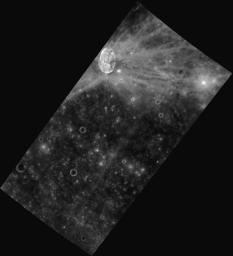This image, taken with the Narrow Angle Camera (NAC), shows the bright rays of Hovnatanian crater. The "butterfly" pattern of the rays, combined with the oval shape of the crater, indicates that the object that formed the crater impacted the surface with an incidence angle of less than 15 degrees (from the horizontal). The floor of the crater contains an impact melt pool toward the south and central-peak type mountains toward the north (displaced from the center due to the highly oblique impact).
This image was acquired as part of MDIS's high-resolution stereo imaging campaign. Images from the stereo imaging campaign are used in combination with the surface morphology base map or the albedo base map to create high-resolution stereo views of Mercury's surface, with an average resolution of 200 meters/pixel. Viewing the surface under the same Sun illumination conditions but from two or more viewing angles enables information about the small-scale topography of Mercury's surface to be obtained.
Date acquired: November 15, 2012
Image Mission Elapsed Time (MET): 261428461
Image ID: 2956833
Instrument: Narrow Angle Camera (NAC) of the Mercury Dual Imaging System (MDIS)
Center Latitude: -10.11°
Center Longitude: 172.8° E
Resolution: 152 meters/pixel
Scale: Hovnatanian crater is approximately 34 km (21 mi) long
Incidence Angle: 12.2°
Emission Angle: 59.6°
Phase Angle: 71.8°
The MESSENGER spacecraft is the first ever to orbit the planet Mercury, and the spacecraft's seven scientific instruments and radio science investigation are unraveling the history and evolution of the Solar System's innermost planet. Visit the Why Mercury? section of this website to learn more about the key science questions that the MESSENGER mission is addressing. During the one-year primary mission, MDIS acquired 88,746 images and extensive other data sets. MESSENGER is now in a year-long extended mission, during which plans call for the acquisition of more than 80,000 additional images to support MESSENGER's science goals.
For information regarding the use of images, see the MESSENGER image use policy.

 Planetary Data System
Planetary Data System












